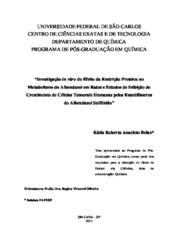Mostrar el registro sencillo del ítem
Investigação in vitro do efeito da restrição proteica no metabolismo do albendazol em ratos e estudos de inibição do crescimento de células tumorais humanas pelos enantiômeros do albendazol sulfóxido
| dc.contributor.author | Belaz, Katia Roberta Anacleto | |
| dc.date.accessioned | 2016-06-02T20:34:32Z | |
| dc.date.available | 2012-02-27 | |
| dc.date.available | 2016-06-02T20:34:32Z | |
| dc.date.issued | 2011-12-02 | |
| dc.identifier.citation | BELAZ, Katia Roberta Anacleto. Investigation in vitro of effect of protein restrict in the metabolism of albendazole in rats and growth inhibition studies in human tumor cells by enantiomers of albendazole sulphoxide. 2011. 205 f. Tese (Doutorado em Ciências Exatas e da Terra) - Universidade Federal de São Carlos, São Carlos, 2011. | por |
| dc.identifier.uri | https://repositorio.ufscar.br/handle/ufscar/6217 | |
| dc.description.abstract | This work presents an in vitro investigation of protein restriction in the metabolism of albendazole (ABZ). The study was conducted with microsomal fractions obtained from Wistar rats using a High Performance Multidimensional Liquid Chromatography method which was developed and fully validated for the determination of the ABZ metabolites albendazole sulphoxide (ABZ-SO), albendazole sulphone (ABZ-SO2) and albendazole 2-aminesulphone (ABZ-SO2-NH2). The compounds were extracted from the biological matrix using a C8-RAM-BSA column (5.0 x 0.46 cm i.d.) and analyzed on a chromatographic chiral column containing amylose tris(3,5- dimethylphenylcarbamate) (15.0 x 0.46 cm i.d.) with a runtime of 35 min. The results of the biotransformation experiments showed that the protein restriction influenced the oxidative metabolism of ABZ. The production of (+) and (-)-ABZ-SO was higher in the control animals. Aditionally, the production of ABZ-SO enantiomers was enantioselective, where the (-)-ABZ-SO was formed in greater amounts than the (+)- ABZ-SO in control animals. However, this enantioselectivity was not observed when the ABZ biotransformation was conducted with microsomal fractions obtained from protein restriction animals. Four chiral polysaccharide phases were also evaluated for the enantioseparation of ABZ-SO in normal and polar organic elution modes. Among the tested conditions, the tris(3,5-dimethylphenylcarbamate) of amylose and MeOH 100% as mobile phase was selected to perform a semipreparative HPLC separation of ()-ABZ-SO. The pure enantiomers obtained were used in in vitro assays to evaluate the growth inhibitory effects on human tumor cells. Inhibition of cell growth was observed to be more pronounced with the (+)-ABZ-SO compared to (-)-ABZ-SO, particularly in MCF-7 cells where the inhibition was about four times more efficient. | eng |
| dc.description.sponsorship | Universidade Federal de Minas Gerais | |
| dc.format | application/pdf | por |
| dc.language | por | por |
| dc.publisher | Universidade Federal de São Carlos | por |
| dc.rights | Acesso Aberto | por |
| dc.subject | Análise cromatográfica | por |
| dc.subject | Desnutrição | por |
| dc.subject | Cromatografia quiral | por |
| dc.subject | Cromatografia líquida de alta eficiência | por |
| dc.subject | Planejamento fatorial | por |
| dc.subject | Injeção direta | por |
| dc.title | Investigação in vitro do efeito da restrição proteica no metabolismo do albendazol em ratos e estudos de inibição do crescimento de células tumorais humanas pelos enantiômeros do albendazol sulfóxido | por |
| dc.title.alternative | Investigation in vitro of effect of protein restrict in the metabolism of albendazole in rats and growth inhibition studies in human tumor cells by enantiomers of albendazole sulphoxide | eng |
| dc.type | Tese | por |
| dc.contributor.advisor1 | Oliveira, Regina Vincenzi | |
| dc.contributor.advisor1Lattes | http://lattes.cnpq.br/6609377714413073 | por |
| dc.description.resumo | Este trabalho apresenta estudos sobre influência da restrição proteica no metabolismo in vitro do albendazol (ABZ). O estudo foi realizado com emprego de frações microssomais de fígados de ratos Wistar, através de um método por Cromatografia Líquida Multidimensional de Alta Eficiência, desenvolvido e validado para a determinação dos metabólitos do ABZ: o albendazol-sulfóxido (ABZ-SO), albendazolsulfona (ABZ-SO2) e o albendazol-2-amino-sulfona (ABZ-NH2-SO2). Os compostos foram extraídos da matriz biológica através do emprego de uma coluna C8-RAM-BSA (5,0 x 0,46 cm d.i.) e analisados em uma coluna cromatográfica quiral tris(3,5- dimetilfenilcarbamato) de amilose (15,0 x 0,46 cm d.i.), em um tempo total de 35 min. Os dados de biotransformação demonstraram que a restrição proteica influenciou o metabolismo oxidativo do ABZ, onde a produção do (+) e (-)-ABZ-SO foi maior nos animais controles. Adicionalmente, a obtenção dos enantiômeros do ABZ-SO foi enantiosseletiva, onde o (-)-ABZ-SO foi produzido em maior quantidade do que o (+)- ABZ-SO em animais controle, porém, essa enantiosseletividade não foi observada quando da análise do metabolismo do ABZ em frações microssomais obtidas de fígados de ratos submetidos a restrição proteica. Ainda neste trabalho, foi realizada a avaliação de quatro fases quirais de polissacarídeos, no modo normal e polar orgânico, para a separação dos enantiômeros do ABZ-SO. Dentre as condiçõess avaliadas, a fase quiral tris(3,5-dimetilfenilcarbamato) de amilose e fase móvel composta por MeOH 100% foram empregadas para realizar a separação em escala semipreparativa do ()- ABZ-SO. Os enantiômeros puros obtidos foram utilizados em ensaios in vitro de inibição do crescimento de células tumorais humanas. Os resultados destes testes mostraram que a inibição do crescimento celular foi aproximadamente 4 vezes maior com o (+)-ABZ-SO do que com o (-)-ABZ-SO, principalmente nas células MCF-7. | por |
| dc.publisher.country | BR | por |
| dc.publisher.initials | UFSCar | por |
| dc.publisher.program | Programa de Pós-Graduação em Química - PPGQ | por |
| dc.subject.cnpq | CIENCIAS EXATAS E DA TERRA::QUIMICA | por |
| dc.contributor.authorlattes | http://lattes.cnpq.br/3633522981711599 | por |
